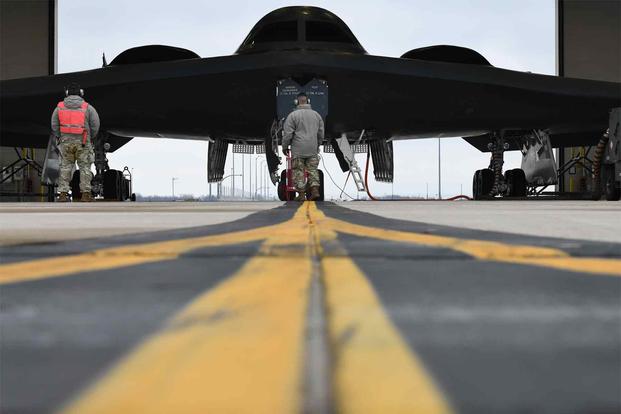
America’s B-2 Spirit fleet resumed flying operations Monday, ending a five-month safety pause after one of the stealth bombers caught fire on a Missouri runway late last year.
Gen. Thomas Bussiere, the head of Air Force Global Strike Command, rescinded the grounding on Thursday, and flights of the bombers — a key component of the country’s so-called nuclear triad — resumed Monday. But it remains unclear what exactly led to the earlier incident and whether a fix was made to the fleet.
“During the safety pause, we erred on the side of prudence and caution to assess any possible safety of flight issues, deliberately and methodically, within the fleet,” Air Force Global Strike Command spokesman Brus Vidal said in an emailed statement. “We successfully accomplished all necessary actions to safely return to full flight operations with the B-2 fleet.”
Read Next: Fired Texas Army Commander Charged with Sex Abuse Faces Court-Martial
The Air Force declined to provide answers when asked by Military.com about what issues were found with the fleet, whether any bombers remain out of commission and if the B-2 that caught fire in Missouri is back in the sky.
Vidal said the information is “privileged” and added that there will be an Aircraft Investigation Board report on why the B-2 caught fire “at some point in the future.”
A B-2 Spirit stealth bomber caught fire at Whiteman Air Force Base, Missouri, on Dec. 10 following an emergency landing.
Master Sgt. Beth Del Vecchio, a spokesman for Whiteman’s 509th Bomb Wing, told Military.com at the time that there were no injuries as a result of the sudden landing or subsequent blaze.
It took 11 days for the base to clear the B-2 from the runway.
There are only 20 B-2 bombers in the Air Force’s fleet, according to a service fact sheet, meaning that putting one out of commission can cause a notable impact to bombing missions. Each B-2 bomber costs approximately $1.157 billion.
The same day as the B-2 fire, the fleet safety pause was ordered. The stealth bomber is a key air component of the U.S. nuclear triad, which also includes nuclear ballistic missiles on land and nuclear submarines at sea.
Vidal said the fleet was still operational during the safety pause.
“Throughout the fleet safety pause, our ability to execute our mission was never at risk: The B-2 fleet could still fly missions on the orders of the President of the United States or in support of the National Command Authority,” Vidal said in an emailed statement. “While the B-2 fleet safety pause is officially over, our ability to deliver nuclear deterrence and provide long-range strike was never in doubt.”
The last major incident with a B-2 prior to the runway fire happened in September 2021, when a stealth bomber rolled off the runway at Whiteman. No one was injured, and the bomber didn’t catch fire. More details emerged about that incident in a March 17, 2022, report from Air Force Global Strike Command.
That plane, assigned to the 393rd Bomb Squadron of Missouri’s 509th Bomb Wing, was known as the Spirit of Georgia. A photo of the mishap was widely shared on social media, showing a jarring image of the massive aircraft slumped into the ground after appearing to have had its landing gear collapse.
That report revealed that the damage estimate to the plane was around $10 million, but further review is still needed. Air Force Col. Robert Cocke, the investigation board president, wrote in the report that the crash likely happened because lock link springs on the landing gear failed to provide sufficient pressure to maintain a locked position.
No error was attributed to the pilot or crew. But the report said there was no requirement for routine replacement of the lock link springs. The last time the bomber went through an in-depth inspection was 2014, according to investigators.
The Air Force unveiled its latest bomber, the B-21 Raider, late last year. It’s the first new bomber in the American military’s fleet in more than 30 years and aims to eventually replace the B-2.
The Pentagon plans to build 100 B-21s, more than the Air Force’s B-2 and B-1B Lancer fleets combined, with an average unit cost for each bomber of nearly $700 million, according to a service fact sheet.
— Thomas Novelly can be reached at [email protected]. Follow him on Twitter @TomNovelly.
Related: B-2 Stealth Bomber Catches Fire After Emergency Landing






